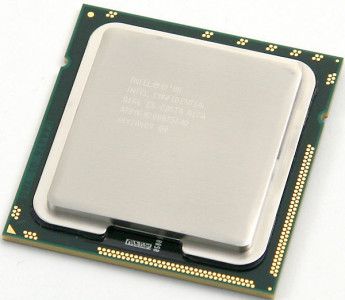From our front-page news:
When Intel launched their Core i7 processors last fall, we, like the rest of the editorial press, we were blown away. Hit with the right workload, the Nehalem architecture blew past not only the competition, but Intel's own Yorkfield as well. As we'd expect, things don't change too much on the server side of things, given the fact that its servers that tend to excel where multi-threading is concerned. HyperThreading worked well in our tests, and it works even better in server applications.
Our friends at The Tech Report have taken the brand-new high-end Xeon CPU for a spin, the 3.2GHz W5580, and are left more than impressed. Thanks to the numerous architectural differences over Yorkfield, and improved design compared to the latest Opterons, the latest Xeon manages to clean house in every-single test... well, all except the power consumption, where it draws more power at full load (to be expected from a 130W processor).
Where memory-intensive applications are concerned, the latest Xeon wins without worry. Thanks to the triple-channel memory controller, and the dropping of latency-plagued FB-DIMMs, the Xeon catches up to the Opteron and blows past it. As we found in our launch Core i7 article, complex algorithms is where the Nehalem architecture shines, and this article has the graphs to prove just how useful that is with server-based scenarios. Oh, but there's one caveat. The $1,600 price tag. That's simply the high-end model reviewed though. There are many more options available for you workstation/server builders working on a more modest budget.

Although we've seen Nehalem on the desktop, it's even more impressive in its dual-socket server/workstation form. That's true for several reasons, including the fact that this architecture was obviously designed with the server market in mind. This system layout translates particularly well into multi-socket systems, where its scalability is quite evident. Another reason Nehalem looks so impressive here is the simple reality that the past few generations of Xeons were handcuffed by FB-DIMMs, not only in due to added power consumption, but also in terms of memory latencies and, as a result, overall performance.
Source: The Tech Report
Our friends at The Tech Report have taken the brand-new high-end Xeon CPU for a spin, the 3.2GHz W5580, and are left more than impressed. Thanks to the numerous architectural differences over Yorkfield, and improved design compared to the latest Opterons, the latest Xeon manages to clean house in every-single test... well, all except the power consumption, where it draws more power at full load (to be expected from a 130W processor).
Where memory-intensive applications are concerned, the latest Xeon wins without worry. Thanks to the triple-channel memory controller, and the dropping of latency-plagued FB-DIMMs, the Xeon catches up to the Opteron and blows past it. As we found in our launch Core i7 article, complex algorithms is where the Nehalem architecture shines, and this article has the graphs to prove just how useful that is with server-based scenarios. Oh, but there's one caveat. The $1,600 price tag. That's simply the high-end model reviewed though. There are many more options available for you workstation/server builders working on a more modest budget.

Although we've seen Nehalem on the desktop, it's even more impressive in its dual-socket server/workstation form. That's true for several reasons, including the fact that this architecture was obviously designed with the server market in mind. This system layout translates particularly well into multi-socket systems, where its scalability is quite evident. Another reason Nehalem looks so impressive here is the simple reality that the past few generations of Xeons were handcuffed by FB-DIMMs, not only in due to added power consumption, but also in terms of memory latencies and, as a result, overall performance.
Source: The Tech Report
